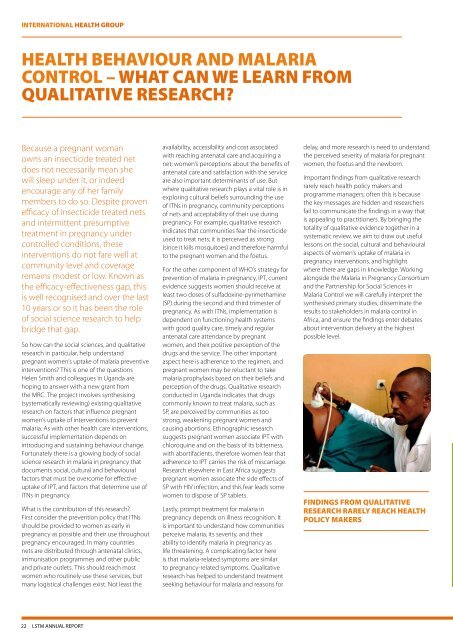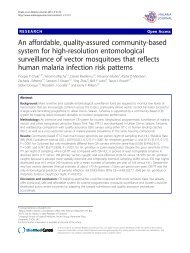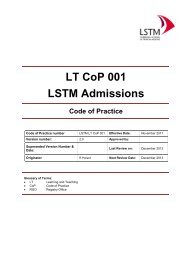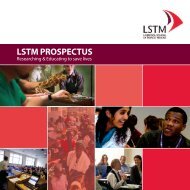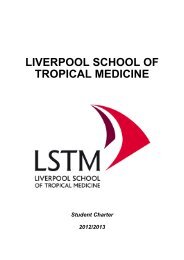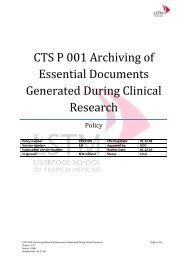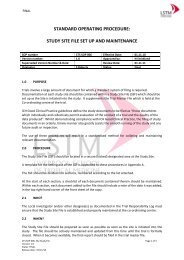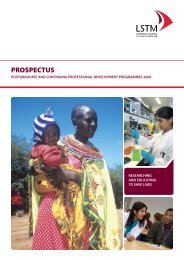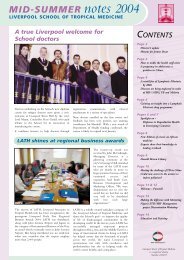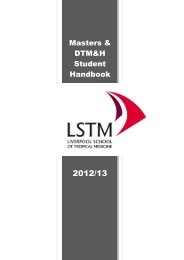Annual Report 2008 - 2009 - Liverpool School of Tropical Medicine
Annual Report 2008 - 2009 - Liverpool School of Tropical Medicine
Annual Report 2008 - 2009 - Liverpool School of Tropical Medicine
Create successful ePaper yourself
Turn your PDF publications into a flip-book with our unique Google optimized e-Paper software.
INTERNATIONAL HEALTH GROUP<br />
HEALTH BEHAVIOUR AND MALARIA<br />
CONTROL – WHAT CAN WE LEARN FROM<br />
QUALITATIVE RESEARCH?<br />
Because a pregnant woman<br />
owns an insecticide treated net<br />
does not necessarily mean she<br />
will sleep under it, or indeed<br />
encourage any <strong>of</strong> her family<br />
members to do so. Despite proven<br />
efficacy <strong>of</strong> insecticide treated nets<br />
and intermittent presumptive<br />
treatment in pregnancy under<br />
controlled conditions, these<br />
interventions do not fare well at<br />
community level and coverage<br />
remains modest or low. Known as<br />
the efficacy-effectiveness gap, this<br />
is well recognised and over the last<br />
10 years or so it has been the role<br />
<strong>of</strong> social science research to help<br />
bridge that gap.<br />
So how can the social sciences, and qualitative<br />
research in particular, help understand<br />
pregnant women’s uptake <strong>of</strong> malaria preventive<br />
interventions? This is one <strong>of</strong> the questions<br />
Helen Smith and colleagues in Uganda are<br />
hoping to answer with a new grant from<br />
the MRC. The project involves synthesising<br />
(systematically reviewing) existing qualitative<br />
research on factors that influence pregnant<br />
women’s uptake <strong>of</strong> interventions to prevent<br />
malaria. As with other health care interventions,<br />
successful implementation depends on<br />
introducing and sustaining behaviour change.<br />
Fortunately there is a growing body <strong>of</strong> social<br />
science research in malaria in pregnancy that<br />
documents social, cultural and behavioural<br />
factors that must be overcome for effective<br />
uptake <strong>of</strong> IPT, and factors that determine use <strong>of</strong><br />
ITNs in pregnancy.<br />
What is the contribution <strong>of</strong> this research?<br />
First consider the prevention policy that ITNs<br />
should be provided to women as early in<br />
pregnancy as possible and their use throughout<br />
pregnancy encouraged. In many countries<br />
nets are distributed through antenatal clinics,<br />
immunisation programmes and other public<br />
and private outlets. This should reach most<br />
women who routinely use these services, but<br />
many logistical challenges exist. Not least the<br />
availability, accessibility and cost associated<br />
with reaching antenatal care and acquiring a<br />
net; women’s perceptions about the benefits <strong>of</strong><br />
antenatal care and satisfaction with the service<br />
are also important determinants <strong>of</strong> use. But<br />
where qualitative research plays a vital role is in<br />
exploring cultural beliefs surrounding the use<br />
<strong>of</strong> ITNs in pregnancy, community perceptions<br />
<strong>of</strong> nets and acceptability <strong>of</strong> their use during<br />
pregnancy. For example, qualitative research<br />
indicates that communities fear the insecticide<br />
used to treat nets; it is perceived as strong<br />
(since it kills mosquitoes) and therefore harmful<br />
to the pregnant women and the foetus.<br />
For the other component <strong>of</strong> WHO’s strategy for<br />
prevention <strong>of</strong> malaria in pregnancy, IPT, current<br />
evidence suggests women should receive at<br />
least two doses <strong>of</strong> sulfadoxine-pyrimethamine<br />
(SP) during the second and third trimester <strong>of</strong><br />
pregnancy. As with ITNs, implementation is<br />
dependent on functioning health systems<br />
with good quality care, timely and regular<br />
antenatal care attendance by pregnant<br />
women, and their positive perception <strong>of</strong> the<br />
drugs and the service. The other important<br />
aspect here is adherence to the regimen, and<br />
pregnant women may be reluctant to take<br />
malaria prophylaxis based on their beliefs and<br />
perception <strong>of</strong> the drugs. Qualitative research<br />
conducted in Uganda indicates that drugs<br />
commonly known to treat malaria, such as<br />
SP, are perceived by communities as too<br />
strong, weakening pregnant women and<br />
causing abortions. Ethnographic research<br />
suggests pregnant women associate IPT with<br />
chloroquine and on the basis <strong>of</strong> its bitterness,<br />
with abortifacients, therefore women fear that<br />
adherence to IPT carries the risk <strong>of</strong> miscarriage.<br />
Research elsewhere in East Africa suggests<br />
pregnant women associate the side effects <strong>of</strong><br />
SP with HIV infection, and this fear leads some<br />
women to dispose <strong>of</strong> SP tablets.<br />
Lastly, prompt treatment for malaria in<br />
pregnancy depends on illness recognition. It<br />
is important to understand how communities<br />
perceive malaria, its severity, and their<br />
ability to identify malaria in pregnancy as<br />
life threatening. A complicating factor here<br />
is that malaria-related symptoms are similar<br />
to pregnancy-related symptoms. Qualitative<br />
research has helped to understand treatment<br />
seeking behaviour for malaria and reasons for<br />
delay, and more research is need to understand<br />
the perceived severity <strong>of</strong> malaria for pregnant<br />
women, the foetus and the newborn.<br />
Important findings from qualitative research<br />
rarely reach health policy makers and<br />
programme managers; <strong>of</strong>ten this is because<br />
the key messages are hidden and researchers<br />
fail to communicate the findings in a way that<br />
is appealing to practitioners. By bringing the<br />
totality <strong>of</strong> qualitative evidence together in a<br />
systematic review, we aim to draw out useful<br />
lessons on the social, cultural and behavioural<br />
aspects <strong>of</strong> women’s uptake <strong>of</strong> malaria in<br />
pregnancy interventions, and highlight<br />
where there are gaps in knowledge. Working<br />
alongside the Malaria in Pregnancy Consortium<br />
and the Partnership for Social Sciences in<br />
Malaria Control we will carefully interpret the<br />
synthesised primary studies, disseminate the<br />
results to stakeholders in malaria control in<br />
Africa, and ensure the findings enter debates<br />
about intervention delivery at the highest<br />
possible level.<br />
FINDINGS FROM QUALITATIVE<br />
RESEARCH RARELY REACH HEALTH<br />
POLICY MAKERS<br />
22 LSTM ANNUAL REPORT


